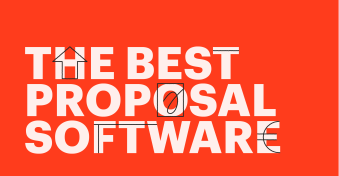So, you want to discover how to write a proposal for a project.
Well, “Let there be light!” This article is here to show you the way.
Let’s start by diving into what a project proposal is.
What is a project proposal?
A project proposal is a detailed document that presents the plan for a specific project to get approval or funding from stakeholders, such as clients, investors or management.
Usually, it specifies the project’s objectives, scope, methodology, resources, timeline and projected outcomes.
What is the purpose of a project proposal, and why do you need one?
The purpose of a project proposal is to present a clear roadmap for the future project and get necessary buy-ins.
We’ve surveyed 720 users of our project proposal templates, and they highlighted the following three goals of writing a project proposal, among others:
- Define clear objectives: specify goals and deliverables for the project, mitigating risks and scope creep.
- Align stakeholder expectations: make sure everyone is on the same page about the project’s scope and purpose.
- Demonstrate feasibility: build a strong case for the project’s success by outlining a detailed execution plan.
→DOWNLOAD NOW: FREE PROJECT PROPOSAL TEMPLATE
What are the benefits of a well-written project proposal?
There are many benefits to writing a clear and comprehensive project proposal compared to a poorly written one:
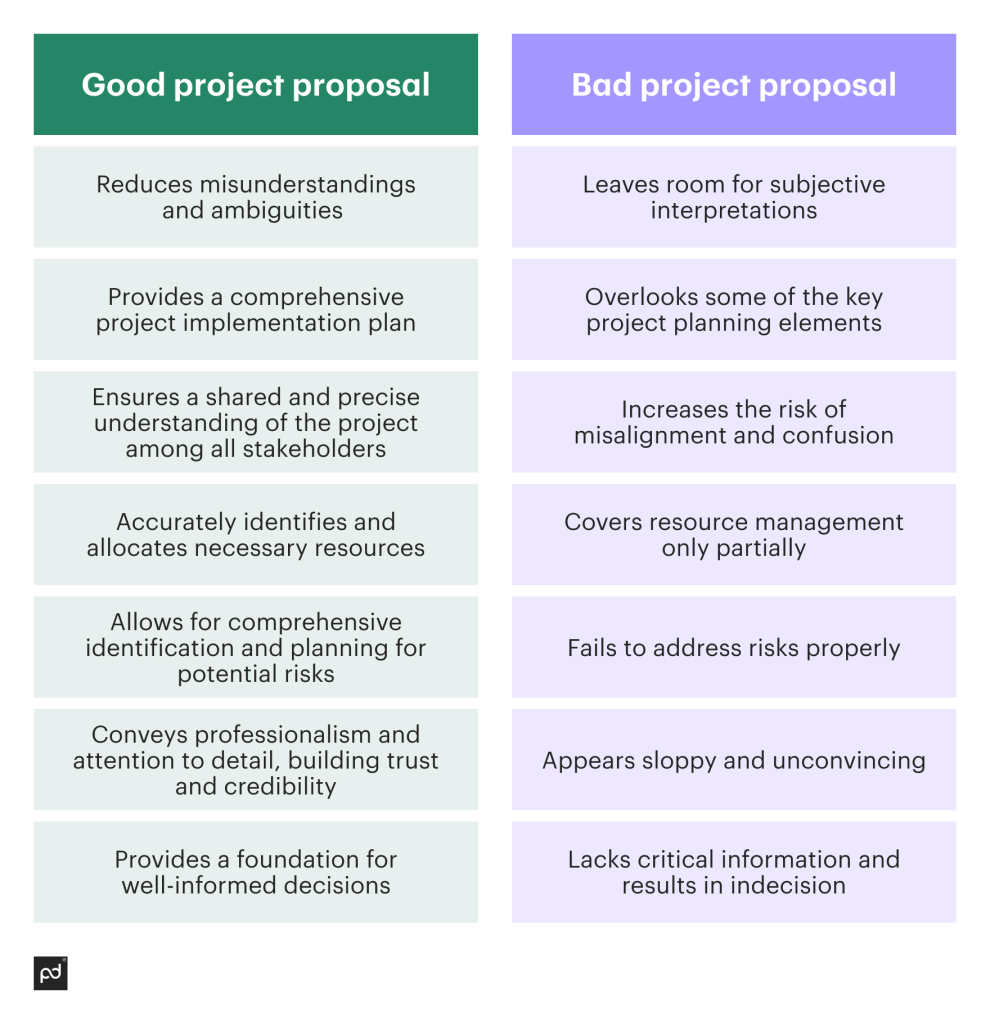
Let’s now look at a detailed proposal structure.
What to include in your project proposal structure
Here is a general project proposal structure that you can adjust to your specific needs:
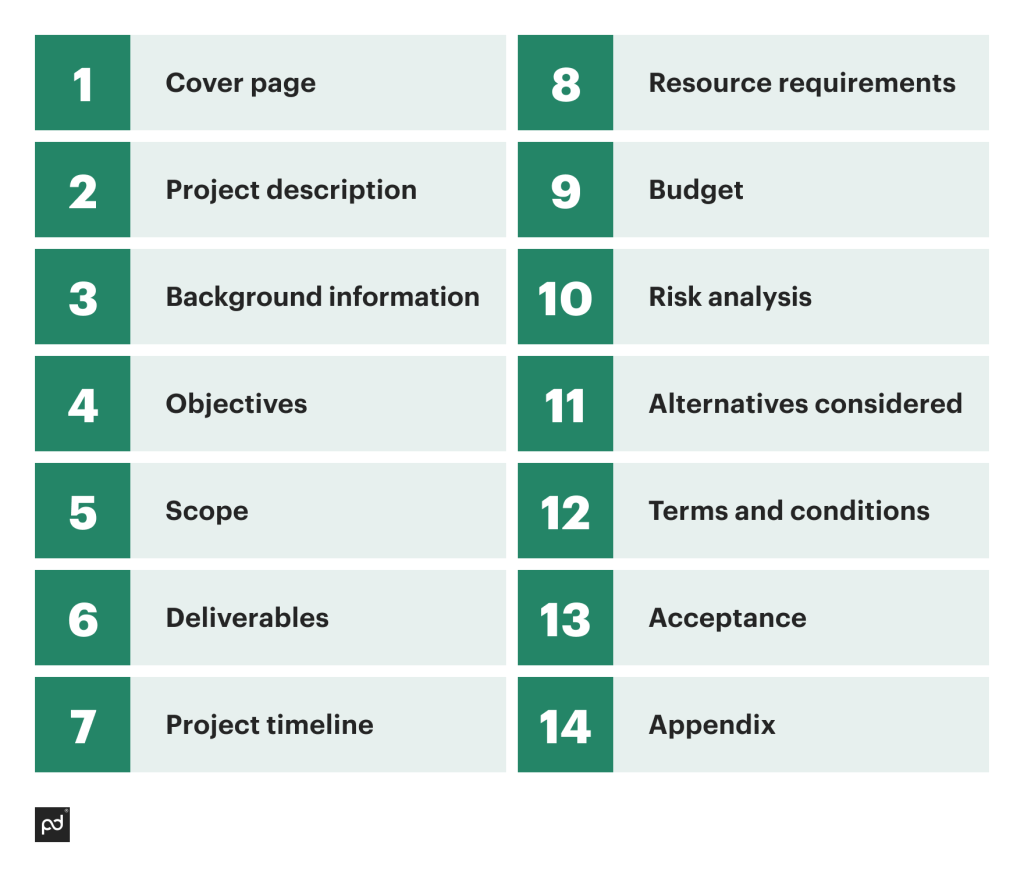
1. Cover page
Add the title of your project, names and roles of people involved, and other data like the project number and initiation date.
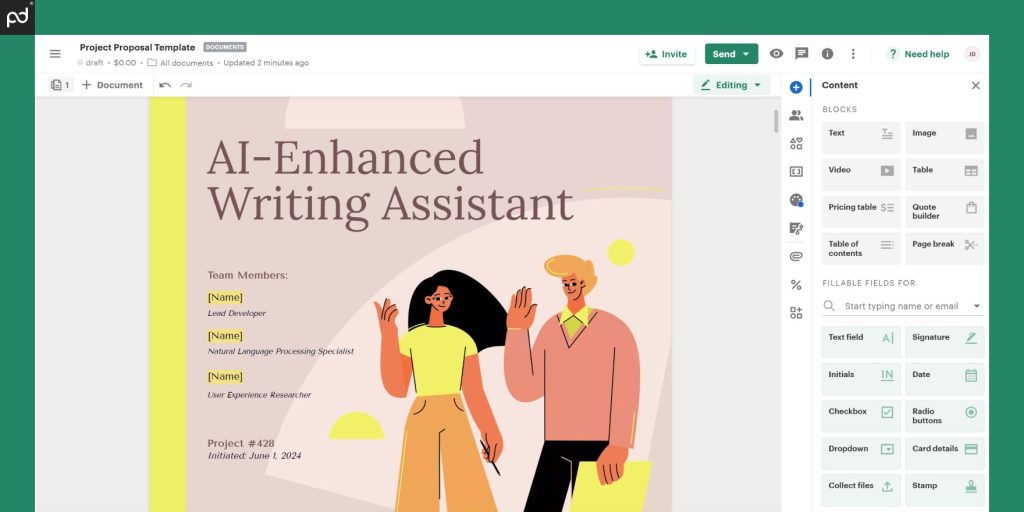
2. Project description
Define the problem, solution, and expected outcomes.
Example:
Project overview: This initiative aims to develop an AI writing tool that produces more natural, human-like text. By analyzing patterns in human writing samples, the tool varies sentence structures and lengths and occasionally inserts minor imperfections like spelling errors or grammar mistakes. This nuanced approach seeks to create AI-generated content that feels authentic while remaining clear and understandable.
3. Background information
Provide information that is important for understanding the purpose and urgency of the project, such as your previous work, relevant literature, or historical data.
Example:
Background: Previous AI language models tended to generate text with rigid adherence to rules, lacking the natural variation of human writing. Our past research examining blogs, novels, and workplace writing revealed a need for more authentic-feeling AI-generated prose. This project builds on those findings.
4. Objectives
Define the project’s goals and success metrics.
Example:
Objectives:
— Create an AI writing model that outputs prose with human-like variations in style, tone, and structure
— Develop algorithms to analyze and replicate common quirks in human writing samples
— Implement user controls to adjust output formality and complexity as needed
— Achieve high ratings (>4 on a 5-point scale) in user testing for online authenticity and readability
5. Scope
Briefly yet clearly outline the project’s scope.
Example:
Scope: The initial scope covers an AI model and tools to generate long-form writing (emails, reports, articles) with customizable levels of human realism. Potential future phases could extend to other domains like storytelling or dialogue.
6. Deliverables
Describe project outcomes, including the product to be delivered, reports, etc.
Example:
Deliverables:
— AI writing model and integrated user interface
— Model training data and linguistic rulesets
— Technical documentation and code repositories
— Research paper detailing approach and findings
7. Project timeline
Include a schedule with stages and defined timeframes.
Example:
Timeline:
— Implementation planning (6 weeks)
— Data collection and annotation (12 weeks)
— Model training and refinement (16 weeks)
— User testing and evaluation (8 weeks)
— Documentation and delivery (4 weeks)
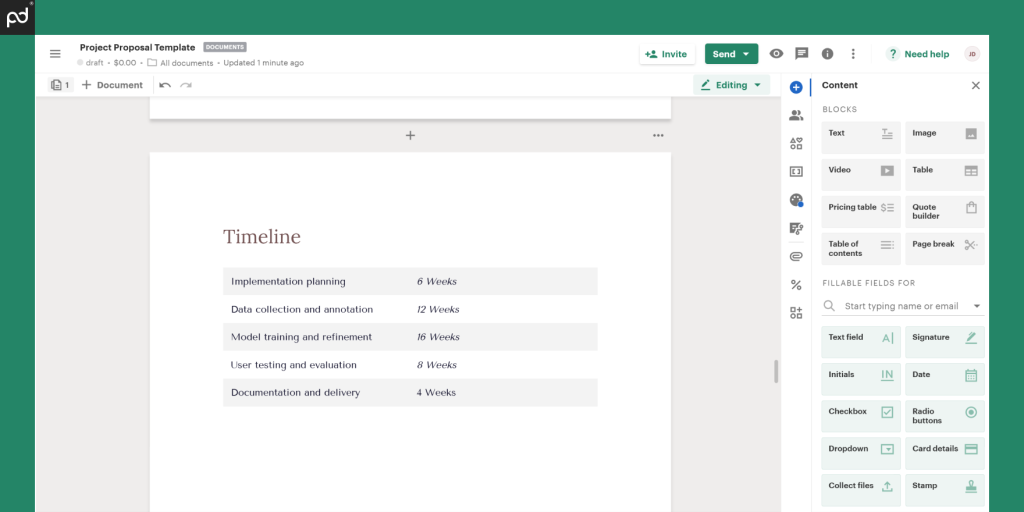
8. Resource requirements
List what is needed to complete the project: personnel, equipment, technology, financial resources, and other materials.
Example:
Resource requirements:
— 3 AI researchers/engineers
— Cloud computing resources for model training
— Access to a corpus of human-written texts
— Usability research staff for prototype testing
9. Budget
Break down all project costs, including labor, materials, overhead, and any additional expenses to illustrate the project’s financial feasibility.
Example:
Budget:
— Personnel: $480,000
— Computing and storage: $75,000
— Research materials: $20,000
— Total: $575,000
10. Risk analysis
Identify foreseeable challenges, evaluate their implications, and propose strategic countermeasures to prevent or mitigate risks while supporting the project’s objectives.
Example:
Potential risks: These include human rater biases during data labeling, overfitting models to limited writing styles, and user rejection of artificial text imperfections. We will employ techniques like randomized rater assignment, model cross-validation, and extensive user testing to mitigate these factors.
11. Alternatives considered
Offer your “plan B” for chosen approaches, technologies, workflows, etc.
Example:
AI model architecture:
— Option 1 (chosen): Transformer-based language model with multi-task learning for style transfer and grammatical error generation
— Alternative: Sequence-to-sequence model with separate components for variation and naturalization
Human writing data:
— Option 1 (chosen): Curated corpus spanning diverse genres (novels, blogs, workplace writing)
— Alternative: Automated web crawling of public online text
User interface:
— Option 1 (chosen): Interactive sliders to adjust realism/complexity level
— Alternative: Predefined style presets (e.g. casual, professional, creative)
12. Terms and conditions
Summarize overall project requirements with concise definitions of what happens if the proposal is approved, including terms of its start, completion deadlines, and penalties for any delays or breaches of the agreement.
Example:
Project initiation: Work shall commence within 14 days of receiving documented approval.
Project duration: All deliverables must be completed within 46 weeks from initiation.
Resources: The approved budget and resource allocations are binding commitments.
Delays: Penalties of 2.5% of the total budget per week of delay beyond the contracted schedule, up to 20% maximum.
Cancellation: The project can be canceled with 30 days’ notice and payment of all completed work.
Acceptance: The final system must meet all acceptance criteria defined during implementation planning.
Confidentiality: All project data, models, and code shall remain strictly confidential property.
13. Acceptance
Formalize approval from stakeholders by collecting their signatures, which will mean that everyone has reviewed and accepted the roadmap outlined in the proposal and is ready to move forward with the project.
To speed up the process, you can use proposal management software that allows signing docs electronically.
We’ve analyzed the performance of project proposals with PandaDoc users and found that e-signature on average helped them save from 6 to 24 hours while completing a document.
Example:
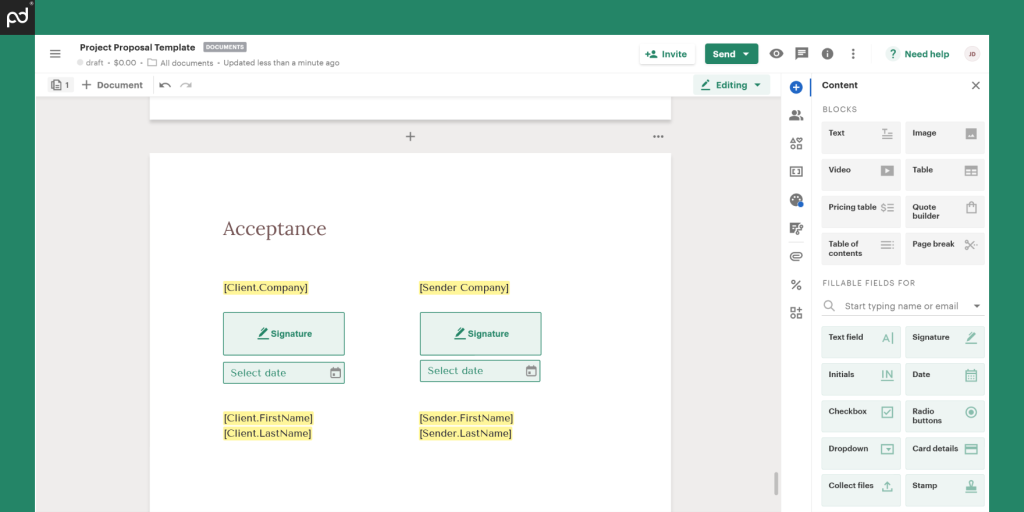
14. Appendix
Include any extra datasets, visual aids, documents, or references that enrich the proposal, offering additional clarity and depth.
Example:
A. Human writing samples:
— Creative fiction excerpt (novel)
— Technical report sample (annual cybersecurity review)
— Email thread (informal workplace communication)
B. Preliminary results:
— Sample model outputs at different realism levels
— Human evaluation study summary (N=35 participants)
C. Linguistic studies on human writing variation:
— “Modeling Grammatical Errors in Informal Text” (Conf. Proc., 2021)
— “Style and Authenticity in Long-Form Writing” (Journal Paper, 2019)
D. Resumes — key personnel
How to write a project proposal
If this is the first time you’re writing a project proposal, check out these project proposal templates to avoid potential mistakes and deliver a professional document that will impress the recipient.
1. Define the problem
Start by considering the problem that you will be addressing.
Describe the pain points succinctly and in a way that resonates with your target audience.
Use facts instead of opinions and rely on data you’ve gathered through research.
Here is an example of a problem definition within a project proposal:
The e-commerce platform has faced an increasing customer churn rate over the past six months. This has risen to 15%, compared to the industry average of 10%, negatively impacting revenue and long-term growth potential.
The primary factors contributing to this problem include a lack of personalized product recommendations, slow website performance, and inadequate customer support.
This issue is worth solving because reducing customer churn will result in higher customer retention, increased customer lifetime value, and greater business profitability.
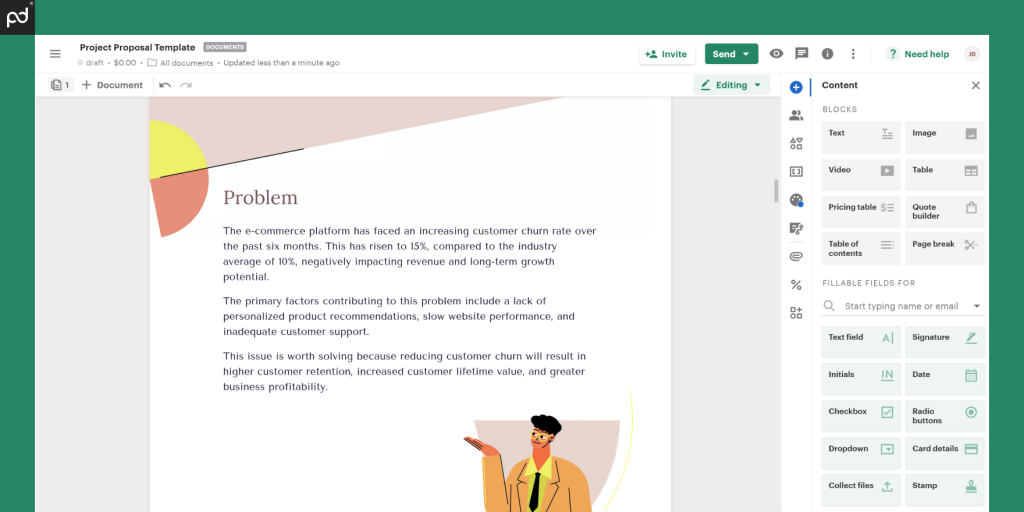
Before embarking on this journey, make sure to understand something referred to as the “triple constraint” — time, scope, and cost — also known as the project management triangle.
Keep in mind your particular triple constraint during every step of the project and remember that a change in one element inevitably affects the others.
For example, extending the functionality of your product will require postponing the deadline, and, most likely, increase the overall costs.
2. Present your solution
Help your audience see that your way of solving the problem is in line with their expectations.
Show/explain why other solutions won’t work (or won’t work as well), and guide the reader through your problem-solving process.
When talking about solutions, anticipate questions and objections and be ready to defend your suggestions.
Do your best to paint a picture that helps the audience understand the solution’s larger impact.
Once again, facts and research-backed examples are your best friends.
3. Define your deliverables
Identify project objectives and break them down into sub-objectives and deliverables.
Deliverables are measurable items that fulfill the objectives of the entire project or separate tasks or processes, and satisfy stakeholders’ requirements.
For example. for the objective ‘Improve the user experience on the e-commerce platform to increase customer satisfaction and reduce churn rate’, sub-objectives and associated deliverables might include:
- Enhance website performance:
- Website performance audit report identifying areas for improvement
- Optimized website with faster page load times
- Website performance monitoring dashboard
- Implement personalized product recommendations:
- Recommendation engine design outlining the algorithm and implementation details
- Fully integrated recommendation engine within the e-commerce platform
- User guide and training materials for the recommendation engine
- Improve customer support:
- Customer support analysis report highlighting areas for improvement
- Revised customer support process flowchart
- Customer support training program for staff
- Updated knowledge base for customer self-service
4. State your strategy
Show the strategic approach you’ll take to achieve the project’s objectives.
To do so, follow these steps:
- Introduce your strategy by providing a brief overview of the approach you’ll take to accomplish the project’s goals.
- Describe the project management methodology you’ll use (e.g., agile, waterfall, or hybrid) and justify your choice based on the project’s nature, complexity, and constraints.
- Detail the specific components and techniques that make up your strategy, like resource allocation, risk management, quality assurance, communication, and change management. Explain how these components will work together to support the project’s objectives.
- Assign roles and responsibilities to each team member and stakeholder, ensuring they can collaborate and communicate efficiently.
- Align key milestones and deadlines with your strategy and include them in the project timeline. Explain how these will help monitor progress, manage risks, and ensure the project stays on track.
- Identify potential challenges and risks that may arise during the project and explain how your strategy addresses them. Discuss your approach to risk management, mitigation, and contingency planning.
- Conclude the strategy section by emphasizing the benefits and advantages of your chosen approach. Explain how your strategy is designed to deliver the desired outcomes and meet stakeholder expectations.
5. Outline your schedule and budget
Break your budget down into categories (tools, supplies, etc.) and include both direct and indirect costs.
Provide as much detail as possible so stakeholders can see you’ve done your research to help them make an informed decision.
Outline your project schedule as precisely as possible.
You can add each separate expenditure item to make your budget fully transparent and aligned with stakeholders’ expectations.
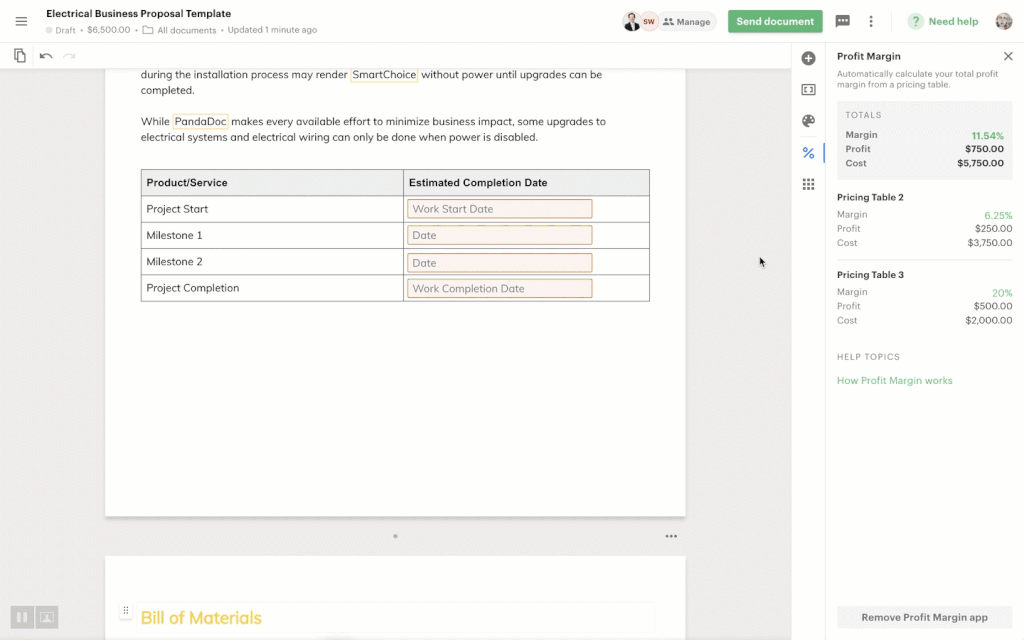
Convey the project lifecycle by communicating concrete start and end times, and do not rely on assumptions within this step!
6. Tie it all together
The conclusion of your project proposal should be a brief recap of what you’ve covered in the body of the document.
Restate the parts you want your recipient to take away: crucial ideas, facts, and (of course) the solutions you’re prepared to deliver.
Your project proposal should tell a story and form a cohesive whole.
Try not to include information that doesn’t contribute to the overall project objectives and ensure all necessary elements of a good proposal — as seen in this article — have been addressed.
7. Edit/proofread your proposal
Before submitting or presenting the proposal, double-check that it’s consistent and easy to follow. Edit it for clarity and added value.
Make sure that your proposal is also well-organized and visually appealing.
Check the tone and language, and don’t forget to proofread for grammar, punctuation, and spelling mistakes.
Asking for feedback is vital, too.
What are the most common types of project proposals?
These are five of the most common types of project proposals, each with different goals to meet different requirements.
1. Formally/informally solicited project proposals
A formally solicited proposal is initiated in response to an RFP (request for proposal), RFQ (request for quote) or IFB (invitation for bid).
These are formal requests used by buyers to gather more information about prospective vendors and their solutions.
An informally solicited project proposal is usually requested in a more casual form, which makes writing it trickier.
It’s because this type of project proposal doesn’t come with the same level of context as the formal proposal, and the project team has to do a lot of research to gather more information about the buyer.
2. Unsolicited project proposals
An unsolicited project proposal is one that no one asked for — but someone may want to see it. Unlike the solicited proposal, it’s initiated by the vendor, not the buyer.
These proposals often stem from your innovative ideas or insights, not from the other party’s requirements.
Essentially, unsolicited project proposals are more complex than an elevator pitch but perhaps less structured than solicited proposals.
With this type of proposals, you have way more freedom in presenting your ideas and highlighting what you think is really important.
3. Continuation project proposals
These are usually done on a calendar basis and are a considerably lower lift in the proposal department, as the project itself has already been approved.
This type of project proposal is created when a project enters a new phase or when new resources are needed to guarantee its continuance.
4. Renewal project proposals
Marginally different from a continuation project proposal, these are written when a project has ended and needs to start up again.
You’ll typically use data from the previous project in your renewal proposal.
5. Supplemental project proposals
These proposals are written when you need more resources than you initially requested or when you’ve gone over budget on the project.
What’s the difference between proposals and other project-related docs?
It’s important not to confuse proposals with other documentation typically associated with delivering a project, such as business proposals, contracts, project charters, and project plans.
Project proposal vs business proposal
A business proposal is like a sales pitch — it aims to sell a product or service to potential clients or investors.
On the other hand, a project proposal outlines objectives for completing a project that doesn’t necessarily have a commercial purpose.
It’s more about presenting a detailed plan rather than delivering a sales pitch.
Project proposal vs contract
A project proposal is not a contract — they serve different purposes in the project’s lifecycle.
Imagine building a house.
Before any work begins, the contractor provides you with a document outlining the design, materials, costs, and timeline so you can decide if they are a good fit.
That’s a project proposal.
In most cases, it doesn’t create legal obligations between the parties.
Now, a contract is when the contractor and you sign a legal agreement specifying the terms and conditions, including the final scope of work, project duration and liabilities.
Unlike the project proposal, it’s legally binding.
Project proposal vs project charter
A project proposal convinces the recipient to accept your offer.
Once your proposal has been green-lighted, you can try to speed up the project development by creating a project charter before really getting things off the ground.
A project charter is an internal document that officially authorizes the start of the project.
It’s intended for your internal team and provides a clear framework for project execution.
A good project charter is brief and formal.
It should talk about the project’s expected timeline, scope, and key planning aspects.
In doing so, it creates a clear mandate for your project manager to hold their staff accountable and work to set deadlines.
Ideally, your project charter should be accepted by the client or project sponsor to ensure clarity and alignment, and mitigate risks.
Project proposal vs project plan
Your project plan is a comprehensive roadmap for success, containing the project’s operational and tactical details.
It goes into much more detail than the project proposal or charter.
The project plan elaborates on how you will achieve your goals with a breakdown of tasks, resource allocation, risk management, quality control measures, and anything else to lay the foundations for the project.
This is because team members must know exactly what they should be doing on a day-to-day basis.
And, if things go wrong, a solid plan can help managers pinpoint where the problem lies.
→DOWNLOAD NOW: FREE PROJECT PLAN TEMPLATE
What’s the difference between a project proposal and a project?
A project proposal is a document that proposes the initiation of a new project, serving as a roadmap outlining its key objectives and deliverables, and seeking the recipient’s approval.
A project is the actual implementation of the plan outlined in the project proposal once it’s been accepted by the recipient.
10 project proposal templates (free downloads)
Even if you’re well-versed in proposal writing, a template can still save you a lot of time and become a good source of inspiration.
Plus, it can help you boost conversion rates.
In this section, we explore ten of our most versatile ready-to-go templates and suggest how to write a proposal for a project example.
You can use all of these templates for free just by creating a PandaDoc account.
1. Standard sales proposal template
This sales proposal template is adaptable and can be used for a variety of purposes: bidding for contracts, acquiring clients, launching new products, making investor presentations, and forming strategic partnerships.
It has all the elements for sales reps to present their offerings in an organized and visually appealing way.
→DOWNLOAD NOW: FREE SALES PROJECT PROPOSAL TEMPLATE
2. Digital marketing project proposal template
A digital marketing proposal template that allows you to quickly craft a proposal highlighting your digital marketing services.
It explains the importance of digital marketing, outlines your strategies, and details your pricing, helping to convert prospects into current clients efficiently.
→DOWNLOAD NOW: FREE DIGITAL MARKETING PROJECT PROPOSAL TEMPLATE
3. Sponsorship project proposal template
Acquiring a sponsor isn’t an easy ride, and a proposal is a perfect chance to highlight your value proposition.
This sponsorship project proposal template explains the benefits of partnering with your organization, outlines the sponsorship packages, and details the associated costs, helping to attract and secure potential sponsors with confidence.
It’s a good idea to include sections on the “Purpose of the project” and the “Target audience profile” near the top of the document.
Remember: customization and personalization are key, so make sure to align your narrative with the expectations of your target sponsors for that perfect pitch.
→DOWNLOAD NOW: FREE SPONSORSHIP PROJECT PROPOSAL TEMPLATE
4. Recruitment project proposal template
Workforce trends like hybrid working and the Great Resignation have created a highly competitive environment for recruiters.
A recruitment project proposal is your chance to stand out to companies looking for recruitment services.
Make sure to add your track record in talent acquisition — for instance, by displaying relevant statistics or case studies.
Finally, provide detailed information on the recruitment process, timelines, and expected outcomes.
This helps potential clients understand the value and efficiency of your services.
→DOWNLOAD NOW: FREE RECRUITMENT PROJECT PROPOSAL TEMPLATE
5. Software development project proposal template
Use this proposal to showcase how reliable your software development services are and how good you are at delivering value to your clients.
Don’t forget to turn your client success stories into a powerful marketing tool — link to any relevant websites and examples of the software you’ve developed.
→DOWNLOAD NOW: FREE SOFTWARE DEVELOPMENT PROPOSAL TEMPLATE
6. Accounting project proposal template
A proper accounting project proposal is a great chance for you to secure long-term partnerships that will grow with the accounting needs of your clients.
Create a document that demonstrates your company is competent and has an eye for detail. Emphasize your knowledge of the regulatory frameworks of the recipient’s industry, and provide fully costed breakdowns of your services.
→DOWNLOAD NOW: FREE ACCOUNTING PROJECT PROPOSAL TEMPLATE
7. Real estate development project proposal template
An outstanding real estate project proposal strikes a balance between comprehensive detail and stunning visual aesthetics.
Inside, your readers should be able to see pictures of your previous projects along with aerial views and technical sketches, which will surely grab their attention.
From here, you can really get stuck into the details of your proposed real estate development.
You should include separate sections for financial, environmental, and location analysis, discussing your methodologies for risk monitoring and resource allocation.
→DOWNLOAD NOW: FREE REAL ESTATE PROJECT PROPOSAL TEMPLATE
8. Search engine optimization (SEO) project proposal template
SEO is a technical topic that most businesses understand the importance of, though very few have the time to devise an in-depth SEO strategy for themselves.
This is where a clear project proposal comes in, translating your line of work into comprehensible terms for those outside your industry.
You may want to begin by explaining a bit about how SEO works before presenting your services as the answer to your client’s needs.
SEO is all about hitting KPIs. So make sure to present relevant statistics, demonstrating ‘before and after’ comparisons of your previous clients’ performance.
→DOWNLOAD NOW: FREE SEO PROJECT PROPOSAL TEMPLATE
9. Venture capital project proposal template
We often talk about short attention spans in business settings, but venture capital takes it to the next level.
Since the industry is so fast-moving, venture capital investors are constantly looking for the next cutting-edge company that can provide a proven business case and ROI.
As such, you need to make your proposal urgent and get right to the point.
Be sure to highlight your value proposition at the top of your document, alongside a summary of your goals and what any investments will go toward.
→DOWNLOAD NOW: FREE VENTURE CAPITAL PROJECT PROPOSAL TEMPLATE
10. Artificial intelligence (AI) project proposal template
Artificial intelligence has taken the world by storm, and there are many lucrative contracts to be won by developers.
However, securing an AI project is no easy task.
Use this project proposal template to foster trust in your company’s solutions and deliverables.
Specify what types of AI you specialize in, and explain their applications to the reader in layman’s terms.
As the AI space is rapidly changing, it’s a good idea to highlight your agile methodologies and ability to adapt to market forces.
→DOWNLOAD NOW: FREE AI PROJECT PROPOSAL TEMPLATE
Top tips on how to approach writing a project proposal
Before writing a project proposal outline
Make sure you consider the following:
- Identify your target audience (your primary decision-makers).
- Determine the type of relationship you’re looking to cultivate with them.
- Think of ways to create this type of relationship.
More questions to ask yourself
Here are just some of the questions worth asking yourself before you get down to work:
- How familiar is your audience with the proposed project scope? What do they know? (And what don’t they know?)
- What do they want to hear? What would be the best way to communicate your idea so it’s easily understood?
- Does your proposal need to provide background information and supplemental material on a particular topic?
Keep potential drawbacks and pitfalls in mind
Project proposals often get rejected within organizations because they:
- Are poorly defined
- Do not align with the goals of the recipient’s organization
- Do not clearly and credibly define the project’s benefits
- Are not effectively presented and sold
Make sure to keep these in mind when crafting your next proposal for max impact.
Data and research are key
When looking at how to write a project proposal, remember that it should be backed up by facts, graphs, figures, and charts.
Do some research on past projects — both successful and unsuccessful — to gather useful data, evidence, and examples to prove your claims.
Examine previous case studies and weave them naturally into your narrative presenting project objectives and proposed solutions.
This should help you create solid project proposals that lead to successful outcomes.
Discover how to write a winning project proposal using PandaDoc
Creating a compelling project proposal is crucial for securing approval and support.
By using specialized document management software, you can streamline and enhance this process. Here’s a step-by-step guide on how to create a project proposal with our suite:
- Use one of the free templates (as seen above).
- Alternatively, create your template from scratch to fit the specific needs of your project.
- Fill in the template with relevant customer and project information.
- Add text, images, videos, tables, checkboxes, and other elements to make your proposal look professional and personalized.
- Prepare the signatory fields to collect e-signatures.
- Send your completed proposal to all parties involved.
You can sign up for a free 14-day trial and explore the process in more detail.
Disclaimer
PandaDoc is not a law firm, or a substitute for an attorney or law firm. This page is not intended to and does not provide legal advice. Should you have legal questions on the validity of e-signatures or digital signatures and the enforceability thereof, please consult with an attorney or law firm. Use of PandaDocs services are governed by our Terms of Use and Privacy Policy.
Originally published December 16, 2021, updated July 29, 2024

